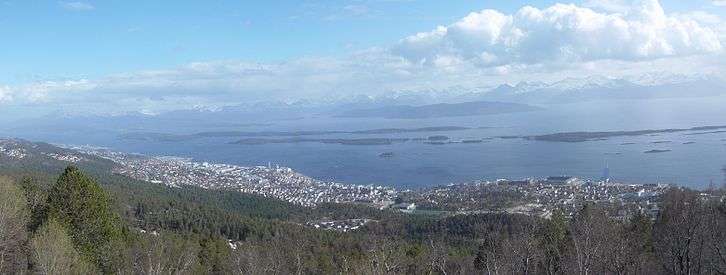Molde
Molde (Norwegian pronunciation: [ˈmɔ̂ldə] (![]()
Molde kommune | |
|---|---|
 Eastward view of Molde. Molde Cathedral (left). | |
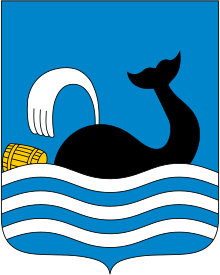 Coat of arms 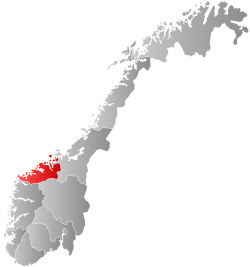 Møre og Romsdal within Norway | |
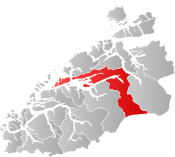 Molde within Møre og Romsdal | |
| Coordinates: 62°45′23″N 07°14′19″E | |
| Country | Norway |
| County | Møre og Romsdal |
| District | Romsdal |
| Established | 1 Jan 1838 |
| Administrative centre | Molde |
| Government | |
| • Mayor (2011) | Torgeir Dahl (H) |
| Area | |
| • Total | 1,503.36 km2 (580.45 sq mi) |
| • Land | 1,434.93 km2 (554.03 sq mi) |
| • Water | 68.43 km2 (26.42 sq mi) 4.6% |
| Area rank | 56 in Norway |
| Population (2020) | |
| • Total | 31,967 |
| • Rank | 31 in Norway |
| • Density | 22.3/km2 (58/sq mi) |
| • Change (10 years) | 7.2% |
| Demonyms | Moldenser Moldensar[1] |
| Time zone | UTC+01:00 (CET) |
| • Summer (DST) | UTC+02:00 (CEST) |
| ISO 3166 code | NO-1506 |
| Official language form | Neutral[2] |
| Website | molde |
The administrative centre of the municipality is the city of Molde which is also the administrative centre of Møre og Romsdal county, the commercial hub of the Romsdal region, and the seat of the Diocese of Møre. Other main population centres in the municipality include the villages of Hjelset, Kleive, Nesjestranda, Midsund, Nord-Heggdal, Eidsvåg, Rausand, Boggestranda, Myklebostad, Eresfjord, and Eikesdalen.
Molde has a maritime, temperate climate, with cool-to-warm summers, and relatively mild winters. The city is nicknamed The Town of Roses.[3]
It is an old settlement which emerged as a trading post in the late Middle Ages. Formal trading rights were introduced in 1614, and the town was incorporated through a royal charter in 1742. Molde was established as a municipality on 1 January 1838 (see formannskapsdistrikt)
The town continued to grow throughout the 18th and 19th centuries, becoming a centre for Norwegian textile and garment industry, as well as the administrative centre for the region, and a major tourist destination. After World War II, Molde experienced accelerated growth, merging with Bolsøy Municipality and parts of Veøy Municipality on 1 January 1964, and has become a centre for not only administrative and public services, but also academic resources and industrial output.
The 1,503-square-kilometre (580 sq mi) municipality is the 56th largest by area out of the 356 municipalities in Norway. Molde is the 31st most populous municipality in Norway with a population of 31,967. The municipality's population density is 22.3 inhabitants per square kilometre (58/sq mi) and its population has increased by 7.2% over the previous 10-year period.[4][5]
History
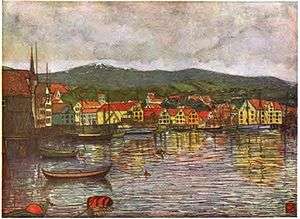
The city's current location dates from the late mediaeval period, but is preceded by the early mediaeval township on Veøya, an island to the south of present-day Molde. The settlement at Veøya probably dates from the Migration Period, but is first mentioned in the sagas by Snorri Sturluson as the location of the Battle of Sekken in 1162, where king Håkon the Broad-shouldered was killed fighting the aristocrat Erling Skakke, during the Norwegian civil wars. However, settlement in the area can be traced much further back in time—evidence given by two rock slabs carved with petroglyphs found at Bjørset, west of the city centre.
At the eve of the 15th century, the influence of Veøya waned, and the island was eventually deserted. However, commercial life in the region was not dead, and originating from the two settlements at Reknes and Molde (later Moldegård), a minor port called Molde Fjære (Molde Landing) emerged, based on trade with timber and herring to foreign merchants.
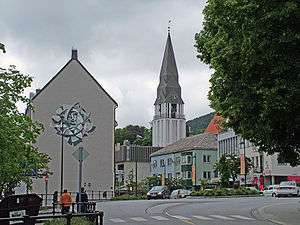
The town gained formal trading rights in 1614 as a ladested under the supervision of the city of Trondheim. During the Swedish occupation of Middle Norway, 1658–1660, after Denmark-Norway's devastating defeat in the Northern Wars, the town became a hub of resistance to the Swedes. After the rebellion and liberation in 1660, Molde became the administrative centre of Romsdalen Amt and was incorporated as a kjøpstad through a royal charter in 1742. Molde continued to grow throughout the 18th and 19th centuries, becoming a centre for Norwegian textile and garment industry. Tourism later became a major industry, and Molde saw notabilities such as the German emperor Wilhelm II of Germany and the Prince of Wales as regular summer visitors. Molde consisted of luxurious hotels surrounding an idyllic township with quaint, wooden houses, lush gardens and parks, esplanades and pavilions, earning it the nickname the Town of Roses. This was interrupted when one third of the city was destroyed in a fire on 21 January 1916. However, Molde recovered and continued to grow in the economically difficult interbellum period.
A second fire, or series of fires, struck from the German air-raids in April and May 1940, which destroyed about two thirds of the town. Molde was in effect the capital of Norway for a week after King Haakon, Crown Prince Olav, and members of the government and parliament arrived at Molde on April 23, after a dramatic flight from Oslo. They were put up at Glomstua, then at the western outskirts of the town, and experienced the bombing raids personally. The Norwegian gold reserve was also conveyed to Molde, and was hidden in a clothing factory.
However, German intelligence was well aware of this, and on April 25 the Luftwaffe initiated a series of air-raids. For a week the air-raid siren on the chimney of the dairy building announced the repeated attacks. April 29 turned out to be the worst day in the history of Molde, as the city was transformed into a sea of flames by incendiary bombs. Until then the church had escaped undamaged, but in the final sortie a firebomb became stuck high up in the tower, and the beautiful wooden church was obliterated by fire.
After World War II, Molde experienced tremendous growth. As the modernisation of the Norwegian society accelerated in the post-reconstruction years, Molde became a centre for not only administrative and public services, but also academic resources and industrial output. After the consolidation of the town itself and its adjacent communities in 1964, Molde became a modern city, encompassing most branches of employment, from farming and fisheries, to industrial production, banking, higher education, tourism, commerce, health care, and civil administration.
Municipality
The town of Molde was established as an urban municipality on 1 January 1838 (see formannskapsdistrikt law). It was surrounded by the rural municipality of Bolsøy. On 1 July 1915, a part of Bolsøy (population: 183) was transferred to the city of Molde. On 1 January 1952, another part of Bolsøy (population: 1,913) was transferred to Molde.
During the 1960s, there were many municipal mergers across Norway due to the work of the Schei Committee. On 1 January 1964, the town of Molde (population: 8,289) merged with the Sekken, Veøya, and Nesjestranda parts of municipality of Veøy (population: 756), all of the municipality of Bolsøy (population: 7,996), and the Mordal area of Nord-Aukra municipality (population: 77) to form the present day municipality of Molde.[6]
On 1 January 2020, the neighbouring municipalities of Midsund and Nesset merged with Molde to form a much larger municipality called Molde.[7]
Name
The city is named after the original settlement on the farmstead of Molde (Old Norse: Moldar). The name is the plural form of either mold which means "fertile soil" or moldr which means "skull" or "mold" (thus in reference to the rounded peaks in Moldemarka).[8]
Pronunciation varies between the standard Molde and the rural Molle. A person from Molde will refer to him/herself as a Moldenser.
Coat of arms
The coat of arms was granted on 29 June 1742. It shows a whale chasing herring into a barrel, based on an old myth that cetaceans guided by the Providence chased, rather than followed, the schools into the fjords at certain times. It also portrays the city's founding industries of herring fisheries and timber exports. Molde was never a whaling port, but the unusually bountiful fisheries in the early 1740s alleviated the city's suffering during a major famine. The sighting of whales, usually pods of orca, was commonly held to be the start of the spring herring fisheries.[9][10]
Moldesangen (The Song of Molde) is the semi-official anthem. It was written by Palle Godtfred Olaus Dørum (1818–1886) and composed by Karl Groos (1789–1861), supposedly in 1818.(Moldesangen)
Geography
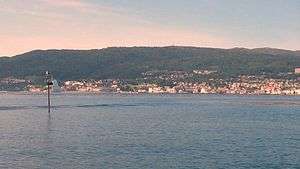
Molde municipality includes part of the Romsdal peninsula as well as many islands. The town of Molde consists of a 10 kilometres (6.2 mi) long and 1 to 2 kilometres (0.62 to 1.24 mi) wide strip of urban land running east–west along the north shore of the Moldefjord, an arm of the Romsdalsfjord, on the Romsdal peninsula. The city is sheltered by Bolsøya and the Molde archipelago, a chain of low-lying islands and islets, to the south, and the wood-clad hills of Moldemarka to the north. The city centre is located just west of the river Moldeelva, which runs into the city from the north, originating in the Moldevatnet lake, through the valley Moldedalen. Despite the river being minor and seasonal, it supported several sawmills in the 16th and 17th centuries. This gave rise to the original town itself through a combination of a good harbour, proximity to the sea routes, vast timber resources, and a river capable of supporting mills. In 1909, the river housed the first hydro electric power plant capable of providing sufficient electricity for the city, and the upper reaches of the river still provide drinking water for most of the city.
Its panoramic view of some 222 partly snow-clad peaks, usually referred to as the Molde panorama, is one of Molde's main attractions, and has drawn tourists to the city since the 19th century. Molde is nicknamed the Town of Roses, a name which originated during Molde's era as a tourist destination of international fame in the late 19th century.
Neighbouring municipalities are Aukra, Gjemnes, and Hustadvika (to the north); Ålesund (to the west); Vestnes and Rauma (to the south); and Tingvoll and Sunndal (to the east).
Points of interest
Salmon, sea trout and sea char are found in the rivers throughout the area, especially the Rauma, Driva, and Eira, already legendary among the British gentry in the mid-19th century. Trout is abundant in most lakes. Cod, pollock, saithe, mackerel and other species of saltwater fish are commonly caught in the Romsdalsfjord, both from land and from boat. Skiing is a popular activity among the inhabitants of Molde in the winter, on groomed tracks, in resorts or by own trail. There are several popular rock climbing, ice climbing, bouldering, glacier and basejumping areas in the immediate vicinity of Molde.
The Atlantic road was voted the Norwegian Construction of the Century in 2005. It is built on bridges and landfills across small islands and skerries, and spans from the small communities of Vikan and Vevang to Averøy, an island with several historic landmarks, such as the Bremsnes cave with Mesolithic findings from the Fosna culture, the mediaeval Kvernes stave church, and Langøysund, now a remote fishing community, but once a bustling port along the main coastal route. Langøysund was the site of the compromise between King Magnus I and the farmers along the coast in 1040. The compromise is regarded as Norway's Magna Carta, and is commemorated though the Pilespisser (English: Arrowheads) monument.
Trollkirka (English: lit. Troll Church) is a marble grotto leading up to an underground waterfall. The grotto is situated 30 minutes outside Molde, followed by a 1-hour hike up a steep trail. Trollveggen is Europe's tallest vertical, overhanging mountain face, with several very difficult climbing routes. Trollstigen is the most visited tourist road in Norway. The road twists and turns its way up an almost vertical mountainside through 11 hairpin bends to an altitude of 858 m (2,814.96 ft). Mardalsfossen is the highest waterfall in Northern Europe and the fourth highest waterfall in the world, cascading 297 metres down into the valley. The total height of the waterfall is 655 m (2,148.95 ft).
Bud is a fishing village on the very tip of the Romsdal peninsula. It gained importance during the Middle Ages as a trading post, and hosted the last free Privy Council of Norway in 1533, a desperate attempt to save the country's independence and stave off the Protestant Reformation, led by Olav Engelbrektsson, archbishop of Nidaros (today Trondheim). The massive Ergan coastal defences, a restored German coastal fort from World War II, and a part of the Atlantic Wall, is situated in Bud. The fishing communities of Ona, Bjørnsund and Håholmen are located on remote islands off the coast, only accessible by boat or ferry.
Moldemarka
Moldemarka, the hilly woodland area north of the city, is public land. The area has an extensive network of paths, walking trails and skiing tracks. Forest roads enter the area from several directions. Bulletin boards and maps provide information regarding local plants and wildlife, as well as signposts along the trails. Marked trails lead to a number of peaks, sites and fishing lakes and rivers. A national fishing licence is required to fish in the lakes and streams.
Varden, 407 metres (1,335 ft) above sea level is a viewpoint directly above Molde, with a good view of the city, the fjord with the Molde archipelago and the Molde panorama.
Climate
Molde has a maritime, temperate climate, with cool-to-warm summers, and relatively mild winters. The annual precipitation is medium high, with an average of 1,640 millimetres (65 in) per year. The warmest season is late summer. Molde holds the national high for the month of October, with 25.6 °C or 78.1 °F (on 11 October 2005). The driest season is May–June.[11] Due to its geographic location, Molde experiences frequent snowfalls in winter, but this snow is usually wet as the winters tend to be mild. Due to the effects of the Gulf Stream, the city rarely experiences lasting cold spells, and the average temperature is well above the average for its latitude.
A natural phenomenon occurring in Molde and the adjacent district, are frequent winter days with temperatures above 10 °C (50 °F), sometimes even above 15 °C (59 °F). This is due to the foehn wind from south and south-east. Combined with a steady influx of warm, moist south-westerly winds from the Atlantic Ocean, warmed by the North Atlantic Current, it gives Molde a climate much warmer than its latitude would indicate. The sheltered location of the city, facing south with hills to the north, mountains to the east and mountainous islands to the west, contributes to Molde's climate and unusually rich plant life, especially among species naturally growing on far lower latitudes, like maple, chestnut, oak, tilia (lime or linden), beech, yew, and others.
| Climate data for Molde | |||||||||||||
|---|---|---|---|---|---|---|---|---|---|---|---|---|---|
| Month | Jan | Feb | Mar | Apr | May | Jun | Jul | Aug | Sep | Oct | Nov | Dec | Year |
| Average high °C (°F) | 1 (34) |
2 (36) |
5 (41) |
7 (45) |
13 (55) |
16 (61) |
17 (63) |
17 (63) |
12 (54) |
9 (48) |
5 (41) |
2 (36) |
9 (48) |
| Average low °C (°F) | −2 (28) |
−2 (28) |
0 (32) |
1 (34) |
7 (45) |
10 (50) |
12 (54) |
11 (52) |
7 (45) |
5 (41) |
1 (34) |
−1 (30) |
4 (39) |
| Average precipitation mm (inches) | 147 (5.8) |
121 (4.8) |
127 (5.0) |
102 (4.0) |
70 (2.8) |
77 (3.0) |
110 (4.3) |
112 (4.4) |
205 (8.1) |
200 (7.9) |
174 (6.9) |
195 (7.7) |
1,640 (64.6) |
| Source: | |||||||||||||
Government
All municipalities in Norway, including Molde, are responsible for primary education (through 10th grade), outpatient health services, senior citizen services, unemployment and other social services, zoning, economic development, and municipal roads. The municipality is governed by a municipal council of elected representatives, which in turn elect a mayor.[12] The municipality falls under the Romsdal District Court and the Frostating Court of Appeal.
Municipal council
The municipal council (Kommunestyre) of Molde is made up of 59 representatives who are elected to four-year terms. The party breakdown of the council is as follows:
| Party Name (in Norwegian) | Number of representatives | |
|---|---|---|
| Labour Party (Arbeiderpartiet) | 8 | |
| Progress Party (Fremskrittspartiet) | 7 | |
| Green Party (Miljøpartiet De Grønne) | 5 | |
| Conservative Party (Høyre) | 15 | |
| Christian Democratic Party (Kristelig Folkeparti) | 3 | |
| Red Party (Rødt) | 1 | |
| Centre Party (Senterpartiet) | 10 | |
| Socialist Left Party (Sosialistisk Venstreparti) | 8 | |
| Liberal Party (Venstre) | 2 | |
| Total number of members: | 59 | |
| Party Name (in Norwegian) | Number of representatives | |
|---|---|---|
| Labour Party (Arbeiderpartiet) | 8 | |
| Progress Party (Fremskrittspartiet) | 4 | |
| Green Party (Miljøpartiet De Grønne) | 2 | |
| Conservative Party (Høyre) | 17 | |
| Christian Democratic Party (Kristelig Folkeparti) | 3 | |
| Centre Party (Senterpartiet) | 3 | |
| Socialist Left Party (Sosialistisk Venstreparti) | 3 | |
| Liberal Party (Venstre) | 3 | |
| Local List(s) (Lokale lister) | 4 | |
| Total number of members: | 47 | |
| Party Name (in Norwegian) | Number of representatives | |
|---|---|---|
| Labour Party (Arbeiderpartiet) | 9 | |
| Progress Party (Fremskrittspartiet) | 5 | |
| Conservative Party (Høyre) | 17 | |
| Christian Democratic Party (Kristelig Folkeparti) | 4 | |
| Centre Party (Senterpartiet) | 3 | |
| Socialist Left Party (Sosialistisk Venstreparti) | 3 | |
| Liberal Party (Venstre) | 6 | |
| Total number of members: | 47 | |
| Party Name (in Norwegian) | Number of representatives | |
|---|---|---|
| Labour Party (Arbeiderpartiet) | 10 | |
| Progress Party (Fremskrittspartiet) | 8 | |
| Conservative Party (Høyre) | 13 | |
| Christian Democratic Party (Kristelig Folkeparti) | 5 | |
| Centre Party (Senterpartiet) | 4 | |
| Socialist Left Party (Sosialistisk Venstreparti) | 4 | |
| Liberal Party (Venstre) | 3 | |
| Total number of members: | 47 | |
| Party Name (in Norwegian) | Number of representatives | |
|---|---|---|
| Labour Party (Arbeiderpartiet) | 9 | |
| Progress Party (Fremskrittspartiet) | 8 | |
| Conservative Party (Høyre) | 15 | |
| Christian Democratic Party (Kristelig Folkeparti) | 4 | |
| Centre Party (Senterpartiet) | 3 | |
| Socialist Left Party (Sosialistisk Venstreparti) | 6 | |
| Liberal Party (Venstre) | 2 | |
| Total number of members: | 47 | |
| Party Name (in Norwegian) | Number of representatives | |
|---|---|---|
| Labour Party (Arbeiderpartiet) | 12 | |
| Conservative Party (Høyre) | 11 | |
| Christian Democratic Party (Kristelig Folkeparti) | 11 | |
| Red Electoral Alliance (Rød Valgallianse) | 1 | |
| Centre Party (Senterpartiet) | 4 | |
| Socialist Left Party (Sosialistisk Venstreparti) | 6 | |
| Liberal Party (Venstre) | 2 | |
| Total number of members: | 47 | |
| Party Name (in Norwegian) | Number of representatives | |
|---|---|---|
| Labour Party (Arbeiderpartiet) | 13 | |
| Progress Party (Fremskrittspartiet) | 4 | |
| Conservative Party (Høyre) | 10 | |
| Christian Democratic Party (Kristelig Folkeparti) | 8 | |
| Centre Party (Senterpartiet) | 6 | |
| Socialist Left Party (Sosialistisk Venstreparti) | 4 | |
| Liberal Party (Venstre) | 2 | |
| Total number of members: | 47 | |
| Party Name (in Norwegian) | Number of representatives | |
|---|---|---|
| Labour Party (Arbeiderpartiet) | 12 | |
| Progress Party (Fremskrittspartiet) | 2 | |
| Conservative Party (Høyre) | 9 | |
| Christian Democratic Party (Kristelig Folkeparti) | 8 | |
| Red Electoral Alliance (Rød Valgallianse) | 1 | |
| Centre Party (Senterpartiet) | 6 | |
| Socialist Left Party (Sosialistisk Venstreparti) | 7 | |
| Liberal Party (Venstre) | 2 | |
| Total number of members: | 47 | |
| Party Name (in Norwegian) | Number of representatives | |
|---|---|---|
| Labour Party (Arbeiderpartiet) | 19 | |
| Progress Party (Fremskrittspartiet) | 7 | |
| Conservative Party (Høyre) | 13 | |
| Christian Democratic Party (Kristelig Folkeparti) | 9 | |
| Red Electoral Alliance (Rød Valgallianse) | 1 | |
| Centre Party (Senterpartiet) | 4 | |
| Socialist Left Party (Sosialistisk Venstreparti) | 5 | |
| Liberal Party (Venstre) | 3 | |
| Total number of members: | 61 | |
| Party Name (in Norwegian) | Number of representatives | |
|---|---|---|
| Labour Party (Arbeiderpartiet) | 20 | |
| Progress Party (Fremskrittspartiet) | 3 | |
| Conservative Party (Høyre) | 14 | |
| Christian Democratic Party (Kristelig Folkeparti) | 10 | |
| Red Electoral Alliance (Rød Valgallianse) | 1 | |
| Centre Party (Senterpartiet) | 5 | |
| Socialist Left Party (Sosialistisk Venstreparti) | 4 | |
| Liberal Party (Venstre) | 4 | |
| Total number of members: | 61 | |
| Party Name (in Norwegian) | Number of representatives | |
|---|---|---|
| Labour Party (Arbeiderpartiet) | 18 | |
| Conservative Party (Høyre) | 17 | |
| Christian Democratic Party (Kristelig Folkeparti) | 11 | |
| Liberal People's Party (Liberale Folkepartiet) | 1 | |
| Red Electoral Alliance (Rød Valgallianse) | 1 | |
| Centre Party (Senterpartiet) | 5 | |
| Socialist Left Party (Sosialistisk Venstreparti) | 3 | |
| Liberal Party (Venstre) | 5 | |
| Total number of members: | 61 | |
| Party Name (in Norwegian) | Number of representatives | |
|---|---|---|
| Labour Party (Arbeiderpartiet) | 19 | |
| Anders Lange's Party (Anders Langes parti) | 1 | |
| Conservative Party (Høyre) | 9 | |
| Christian Democratic Party (Kristelig Folkeparti) | 14 | |
| New People's Party (Nye Folkepartiet) | 2 | |
| Centre Party (Senterpartiet) | 10 | |
| Socialist Left Party (Sosialistisk Venstreparti) | 3 | |
| Liberal Party (Venstre) | 3 | |
| Total number of members: | 61 | |
| Party Name (in Norwegian) | Number of representatives | |
|---|---|---|
| Labour Party (Arbeiderpartiet) | 23 | |
| Conservative Party (Høyre) | 8 | |
| Christian Democratic Party (Kristelig Folkeparti) | 11 | |
| Centre Party (Senterpartiet) | 8 | |
| Socialist People's Party (Sosialistisk Folkeparti) | 3 | |
| Liberal Party (Venstre) | 8 | |
| Total number of members: | 61 | |
| Party Name (in Norwegian) | Number of representatives | |
|---|---|---|
| Labour Party (Arbeiderpartiet) | 24 | |
| Conservative Party (Høyre) | 9 | |
| Christian Democratic Party (Kristelig Folkeparti) | 9 | |
| Centre Party (Senterpartiet) | 7 | |
| Socialist People's Party (Sosialistisk Folkeparti) | 3 | |
| Liberal Party (Venstre) | 9 | |
| Total number of members: | 61 | |
| Party Name (in Norwegian) | Number of representatives | |
|---|---|---|
| Labour Party (Arbeiderpartiet) | 25 | |
| Conservative Party (Høyre) | 11 | |
| Christian Democratic Party (Kristelig Folkeparti) | 11 | |
| Centre Party (Senterpartiet) | 6 | |
| Socialist People's Party (Sosialistisk Folkeparti) | 1 | |
| Liberal Party (Venstre) | 7 | |
| Total number of members: | 61 | |
| Party Name (in Norwegian) | Number of representatives | |
|---|---|---|
| Labour Party (Arbeiderpartiet) | 15 | |
| Conservative Party (Høyre) | 8 | |
| Communist Party (Kommunistiske Parti) | 1 | |
| Christian Democratic Party (Kristelig Folkeparti) | 7 | |
| Liberal Party (Venstre) | 6 | |
| Total number of members: | 37 | |
| Party Name (in Norwegian) | Number of representatives | |
|---|---|---|
| Labour Party (Arbeiderpartiet) | 14 | |
| Conservative Party (Høyre) | 8 | |
| Communist Party (Kommunistiske Parti) | 1 | |
| Christian Democratic Party (Kristelig Folkeparti) | 7 | |
| Liberal Party (Venstre) | 7 | |
| Total number of members: | 37 | |
| Party Name (in Norwegian) | Number of representatives | |
|---|---|---|
| Labour Party (Arbeiderpartiet) | 13 | |
| Conservative Party (Høyre) | 7 | |
| Communist Party (Kommunistiske Parti) | 1 | |
| Christian Democratic Party (Kristelig Folkeparti) | 7 | |
| Liberal Party (Venstre) | 8 | |
| Total number of members: | 36 | |
| Party Name (in Norwegian) | Number of representatives | |
|---|---|---|
| Labour Party (Arbeiderpartiet) | 8 | |
| Conservative Party (Høyre) | 5 | |
| Communist Party (Kommunistiske Parti) | 3 | |
| Christian Democratic Party (Kristelig Folkeparti) | 5 | |
| Liberal Party (Venstre) | 7 | |
| Total number of members: | 28 | |
| Party Name (in Norwegian) | Number of representatives | |
|---|---|---|
| Labour Party (Arbeiderpartiet) | 10 | |
| Communist Party (Kommunistiske Parti) | 3 | |
| Christian Democratic Party (Kristelig Folkeparti) | 4 | |
| Liberal Party (Venstre) | 5 | |
| Joint List(s) of Non-Socialist Parties (Borgerlige Felleslister) | 6 | |
| Total number of members: | 28 | |
| Party Name (in Norwegian) | Number of representatives | |
|---|---|---|
| Labour Party (Arbeiderpartiet) | 10 | |
| Liberal Party (Venstre) | 10 | |
| Joint List(s) of Non-Socialist Parties (Borgerlige Felleslister) | 8 | |
| Total number of members: | 28 | |
| Party Name (in Norwegian) | Number of representatives | |
|---|---|---|
| Labour Party (Arbeiderpartiet) | 8 | |
| Communist Party (Kommunistiske Parti) | 1 | |
| Liberal Party (Venstre) | 9 | |
| Joint List(s) of Non-Socialist Parties (Borgerlige Felleslister) | 10 | |
| Total number of members: | 28 | |
| Party Name (in Norwegian) | Number of representatives | |
|---|---|---|
| Labour Party (Arbeiderpartiet) | 9 | |
| Liberal Party (Venstre) | 8 | |
| Joint List(s) of Non-Socialist Parties (Borgerlige Felleslister) | 10 | |
| Local List(s) (Lokale lister) | 1 | |
| Total number of members: | 28 | |
Mayor
The mayors of Molde (incomplete list):
- 2011–present: Torgeir Dahl (H)
- 2003-2011: Jan Petter Hammerø (H)
- 1998-2003: Rolf Myhre (KrF)
- 1994-1998: Einar Øveraas (H)
- 1990-1993: Rolf Myhre (KrF)
- 1986-1989: Ragnar Heggdal (H)
- 1984-1985: Rolf Myhre (KrF)
- 1982-1983: Asmund Fredly (KrF)
- 1980-1981: Bernt Vilnes (H)
- 1978-1979: Asmund Fredly (KrF)
Culture

Three of the four great Norwegian authors are connected to Molde. Bjørnstjerne Bjørnson spent his childhood years at Nesset outside Molde, and attended school in the city. Henrik Ibsen frequently spent his vacations at the mansion Moldegård visiting the family Møller; and Alexander Kielland resided in the city as the governor of Romsdals amt. Ibsen's play Rosmersholm is generally thought to be inspired by life at the mansion Moldegård, and The Lady from the Sea is also believed to be set in the city of Molde, although never actually mentioned. Other authors from or with ties to Molde include Edvard Hoem, Jo Nesbø, Knut Ødegård, and Nini Roll Anker, a friend of Sigrid Undset.
The Romsdal Museum, one of Norway's largest folk museums, was established in 1912. Buildings originating from all over the region have been moved here to form a typical cluster of farm buildings including "open hearth" houses, sheds, outhouses, smokehouses and a small chapel. The "town street" with Mali's Café shows typical Molde town houses from the pre-World War I period. The Museum of the Fisheries is an open-air museum located on the island of Hjertøya, 10 minutes from the centre of Molde. A small fishing village with authentic buildings, boats and fishing equipment, the museum shows local coastal culture from 1850 onwards.
The local newspaper is Romsdals Budstikke.[33]
Churches
The Church of Norway has ten parishes (sokn) within the municipality of Molde. It is part of the Molde domprosti (arch-deanery) in the Diocese of Møre.
| Parish (sokn) | Church name | Location of the church | Year built |
|---|---|---|---|
| Molde | Molde Cathedral | Molde | 1957 |
| Bolsøy | Røbekk Church | Røbekk | 1898 |
| Nordbyen Church | Molde | 2006 | |
| Bergmo Church | Molde | 1982 | |
| Eikesdal | Eikesdal Church | Eikesdalen | 1866 |
| Eresfjord | Sira Church | Eresfjord | 1869 |
| Kleive | Kleive Church | Kleive | 1858 |
| Midsund | Otrøy Church | Uglvik, Otrøya | 1878 |
| Nord-Heggdal Chapel | Nord-Heggdal | 1974 | |
| Nesset | Nesset Church | Eidsvåg | 1878 |
| Røvik og Veøy | Røvik Church | Røvika | 1905 |
| Veøy Church | Sølsnes | 1907 | |
| Old Veøy Church | Veøya | c. 1200 | |
| Sekken | Sekken Church | Sekken | 1908 |
| Vistdal | Vistdal Church | Myklebostad | 1869 |
Festivals
The Moldejazz jazz festival is held in Molde every July. Moldejazz is one of the largest and oldest jazz festivals in Europe, and one of the most important. An estimated 40,000 tickets are sold for the more than a hundred events during the festival. Between 80,000 and 100,000 visitors visit the city during the one-week-long festival.
Every August, Molde and Nesset are hosts to the Bjørnson Festival, an international literature festival. Established by the poet Knut Ødegård in connection with the 250-year anniversary of Molde, the festival is named in honour of the Nobel Prize in Literature laureate Bjørnstjerne Bjørnson (1832–1910). It is the oldest and the most internationally acclaimed literature festival in Norway.
In addition to the two major events, a number of minor festivals are held annually. Byfest, the city's celebration of incorporation, is an arrangement by local artists, coinciding with the anniversary of the royal charter of 29 June 1742.
Education
Molde University College offers a wide range of academic opportunities, from nursing and health-related studies, to economics and administrative courses. The school is Norway's leading college in logistics,[34] and well established as a centre for research and academic programmes in information technology, with degrees up to and including PhD.
Molde University College is also one of the country's leading institutions in international student exchange and programmes conducted in English.
Transportation
Hurtigruta calls on Molde every day, on its journey between Bergen and Kirkenes. The nearest railway station is Åndalsnes, the terminus for the Rauma Line.
The local airport is Molde Airport which has several daily flights to Oslo, Bergen, and Trondheim, as well as weekly flights to other domestic and international destinations.
The European route E39 and Norwegian County Road 64 both pass through the municipality. The city of Molde is connected to Fræna Municipality (to the north) by the Tussen Tunnel. The city is connected to the Røvika and Nesjestranda part of the municipality by the Fannefjord Tunnel and Bolsøy Bridge, significantly shortening the drive by avoiding driving all the way around the Fannefjorden. The proposed Langfjord Tunnel would connect Molde Municipality to Rauma Municipality via a tunnel under the Langfjorden.
Sports
Molde hosts a variety of sports teams, most notably the football team, Molde FK, which plays in the Eliteserien, the top division in the Norwegian football league system. Their home matches are played at Aker stadion, inaugurated in 1998, which holds a record attendance of 13,308. The team is four-time league champions (2011, 2012, 2014 and 2019), four-time Norwegian Cup winners (1994, 2005, 2013 and 2014), and has made numerous appearances in European tournaments, including the UEFA Champions League. The club was founded in 1911, during Molde's period of great British and Continental influx, and was first named "International", since it predominantly played teams made up from crews of foreign vessels visiting the city.
In addition to a number of international players, the city has also produced several ski jumpers, cross-country skiers and alpine skiers of international merit.
Other sports include the accomplished team handball clubs (Molde HK, SK Træff, SK Rival), athletics teams (IL Molde-Olymp), skiing clubs, basketball and volleyball teams.
International relations
Notable residents
- Nini Roll Anker (1873–1942), writer
- Bjørnstjerne Bjørnson, writer, Nobel Prize laureate (1832–1910)
- Kjell Magne Bondevik, politician, former Prime Minister (1947-)
- Ane Brun, singer-songwriter
- Bjørn Rune Gjelsten, businessman (1956-)
- Maurycy Gottlieb, artist
- Bjørn Trygve Grydeland, President of ESA, EU Ambassador (1949-)
- Birger Hatlebakk (1912–1997), industrialist
- Edvard Hoem, writer
- Ola Kvernberg, musician
- Nicholas Lawson (1790-1851) - vice governor of Galápagos for the Republic of the Equator [36]
- Ann-Helen Moen, soprano [37]
- Arild Monsen, cross-country skier (1962-)
- Jo Nesbø, writer (1960-)
- Arne Nøst, artist
- Knut Ødegård, poet (1945-)
- Ole Anton Qvam (1834–1904) former Prime Minister
- Kjetil Rekdal, football player and manager (1968-)
- Kjell Inge Røkke, businessman (1958-)
- Terje Rypdal, composer and musician
- Kurt Schwitters, (1887–1948) German artist
- Arne Solli, former Commander-in-Chief
- Jacob Tanner, (1865–1964) Norwegian American Lutheran educator and religious author
- Terje Venaas, musician
International footballers
Athletes
- Otto Berg, long jumper
- Johan Remen Evensen, ski jumper, former world record-holder
- Andrine Flemmen, Olympic alpine skier
- Arild Monsen, cross-country skier, World Champion 1985
- Ingolf Mork, ski jumper, winner of Four Hills Tournament 1971/72
- Ragnhild Mowinckel, alpine skier, Olympic medalist 2018
References
- "Navn på steder og personer: Innbyggjarnamn" (in Norwegian). Språkrådet.
- "Forskrift om målvedtak i kommunar og fylkeskommunar" (in Norwegian). Lovdata.no.
- "Molde - Jazz, roses and panoramic views". Visit Norway. Retrieved 18 August 2018.
- Statistisk sentralbyrå (2020). "Table: 06913: Population 1 January and population changes during the calendar year (M)" (in Norwegian).
- Statistisk sentralbyrå (2020). "09280: Area of land and fresh water (km²) (M)" (in Norwegian).
- Jukvam, Dag (1999). "Historisk oversikt over endringer i kommune- og fylkesinndelingen" (PDF) (in Norwegian). Statistisk sentralbyrå.
- "Nye Molde" (in Norwegian). Retrieved 2017-10-15.
- Rygh, Oluf (1908). Norske gaardnavne: Romsdals amt (in Norwegian) (13 ed.). Kristiania, Norge: W. C. Fabritius & sønners bogtrikkeri. p. 280.
- Kvernberg, Anders (2012). Moldes byvåpen fra lakksegl til dataskjerm. Romsdalsmuseets årbok. p. 160ff.
- "Civic heraldry of Norway - Norske Kommunevåpen". Heraldry of the World. Retrieved 2019-06-30.
- "Normaler for Molde" (in Norwegian).
- Hansen, Tore, ed. (2016-05-12). "kommunestyre". Store norske leksikon (in Norwegian). Kunnskapsforlaget. Retrieved 2019-04-06.
- "Tall for Norge: Kommunestyrevalg 2019 - Møre og Romsdal" (in Norwegian). Statistics Norway. Retrieved 2019-10-19.
- "Table: 04813: Members of the local councils, by party/electoral list at the Municipal Council election (M)" (in Norwegian). Statistics Norway.
- "Tall for Norge: Kommunestyrevalg 2011 - Møre og Romsdal" (in Norwegian). Statistics Norway. Retrieved 2019-10-19.
- "Kommunestyrevalget 1995" (PDF) (in Norwegian). Oslo-Kongsvinger: Statistisk sentralbyrå. 1996. Retrieved 2020-05-01.
- "Kommunestyrevalget 1991" (PDF) (in Norwegian). Oslo-Kongsvinger: Statistisk sentralbyrå. 1993. Retrieved 2020-05-01.
- "Kommunestyrevalget 1987" (PDF) (in Norwegian). Oslo-Kongsvinger: Statistisk sentralbyrå. 1988. Retrieved 2020-05-01.
- "Kommunestyrevalget 1983" (PDF) (in Norwegian). Oslo-Kongsvinger: Statistisk sentralbyrå. 1984. Retrieved 2020-05-01.
- "Kommunestyrevalget 1979" (PDF) (in Norwegian). Oslo: Statistisk sentralbyrå. 1979. Retrieved 2020-05-01.
- "Kommunevalgene 1975" (PDF) (in Norwegian). Oslo: Statistisk sentralbyrå. 1977. Retrieved 2020-05-01.
- "Kommunevalgene 1972" (PDF) (in Norwegian). Oslo: Statistisk sentralbyrå. 1973. Retrieved 2020-05-01.
- "Kommunevalgene 1967" (PDF) (in Norwegian). Oslo: Statistisk sentralbyrå. 1967. Retrieved 2020-05-01.
- "Kommunevalgene 1963" (PDF) (in Norwegian). Oslo: Statistisk sentralbyrå. 1964. Retrieved 2020-05-01.
- "Kommunevalgene og Ordførervalgene 1959" (PDF) (in Norwegian). Oslo: Statistisk sentralbyrå. 1960. Retrieved 2020-05-01.
- "Kommunevalgene og Ordførervalgene 1955" (PDF) (in Norwegian). Oslo: Statistisk sentralbyrå. 1957. Retrieved 2020-05-01.
- "Kommunevalgene og Ordførervalgene 1951" (PDF) (in Norwegian). Oslo: Statistisk sentralbyrå. 1952. Retrieved 2020-05-01.
- "Kommunevalgene og Ordførervalgene 1947" (PDF) (in Norwegian). Oslo: Statistisk sentralbyrå. 1948. Retrieved 2020-05-01.
- "Kommunevalgene og Ordførervalgene 1945" (PDF) (in Norwegian). Oslo: Statistisk sentralbyrå. 1947. Retrieved 2020-05-01.
- "Kommunevalgene og Ordførervalgene 1937" (PDF) (in Norwegian). Oslo: Statistisk sentralbyrå. 1938. Retrieved 2020-05-01.
- "Kommunevalgene og Ordførervalgene 1934" (PDF) (in Norwegian). Oslo: Statistisk sentralbyrå. 1935. Retrieved 2020-05-03.
- "Kommunevalgene og Ordførervalgene 1931" (PDF) (in Norwegian). Oslo: Statistisk sentralbyrå. 1932. Retrieved 2020-05-03.
- "rbnett.no" (in Norwegian). Romsdals Budstikke. Retrieved 2007-09-24.
- "Archived copy". Archived from the original on 2018-03-30. Retrieved 2014-12-01.CS1 maint: archived copy as title (link)
- "Vennskapsbyer". kommune.no. Archived from the original on 4 March 2016. Retrieved 26 April 2014.
- "Norwegian Who Inspired Darwin". ThorNews. Retrieved July 15, 2016.
- Ann-Helen Moen at annhelenmoen.com
- "John Arne Riise". Store Norske Leksikon (in Norwegian). Kunnskapsforlaget. Retrieved 10 May 2012.
External links
- Municipal fact sheet from Statistics Norway (in Norwegian)
| Wikimedia Commons has media related to Molde. |
| Wikivoyage has a travel guide for Molde. |
- Tourist information
- Molde University college
- Molde International Jazz Festival
- Romsdals Budstikke
- Molde F.K.
- VS Molde Futsal
- Molde and the Molde Panorama
- Images from Molde and Romsdal by Armin Burkhart
